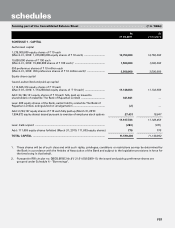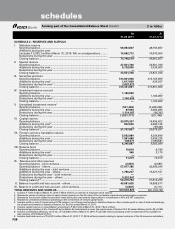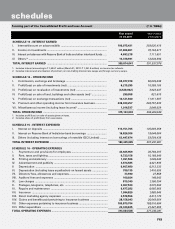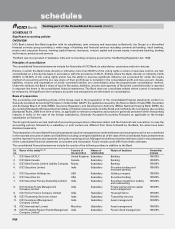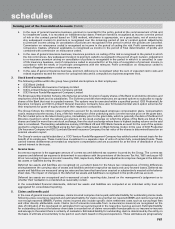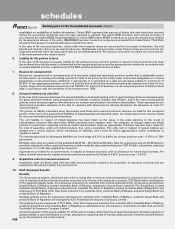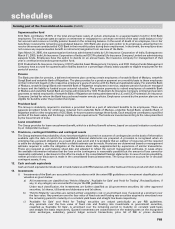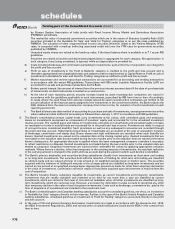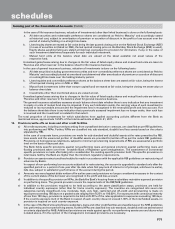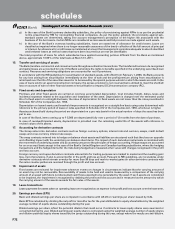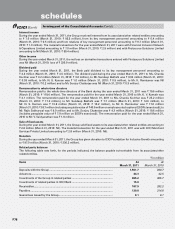ICICI Bank 2011 Annual Report Download - page 144
Download and view the complete annual report
Please find page 144 of the 2011 ICICI Bank annual report below. You can navigate through the pages in the report by either clicking on the pages listed below, or by using the keyword search tool below to find specific information within the annual report.
F66
SIGNIFICANT ACCOUNTING POLICIES
1. Transactions involving foreign exchange
The consolidated financial statements of the Group are reported in Indian rupees (`), the national currency of India. Foreign
currency income and expenditure items are translated as follows:
•For domestic operations, at the exchange rates prevailing on the date of the transaction with the resultant gain or loss
accounted for in the profit and loss account.
•For integral foreign operations, at weekly average closing rates with the resultant gain or loss accounted for in the profit and
loss account. An integral foreign operation is a subsidiary, associate, joint venture or branch of the reporting enterprise,
the activities of which are based or conducted in a country other than the country of the reporting enterprise but are an
integral part of the reporting enterprise.
•For non-integral foreign operations, at the quarterly average closing rates with the resultant gains or losses accounted for
as foreign currency translation reserve.
Monetary foreign currency assets and liabilities of domestic and integral foreign operations are translated at closing exchange
rates notified by Foreign Exchange Dealers’ Association of India (FEDAI) at the balance sheet date and the resulting profits/
losses are included in the profit and loss account.
Both monetary and non-monetary foreign currency assets and liabilities of non-integral foreign operations are translated at
closing exchange rates notified by FEDAI at the balance sheet date and the resulting profits/losses from exchange differences
are accumulated in the foreign currency translation reserve until the disposal of the net investment in the non-integral foreign
operations.
The premium or discount arising on inception of forward exchange contracts in domestic operations that are entered to
establish the amount of reporting currency required or available at the settlement date of a transaction is amortised over the
life of the contract. All other outstanding forward exchange contracts are revalued at the exchange rates notified by FEDAI
for specified maturities and at interpolated rates for contracts of interim maturities. The contracts of longer maturities where
exchange rates are not notified by FEDAI, are revalued at the forward exchange rates implied by the swap curves for respective
currencies. The resultant gains or losses are recognised in the profit and loss account.
Contingent liabilities on account of guarantees, endorsements and other obligations denominated in foreign currency are
disclosed at the closing exchange rates notified by FEDAI at the balance sheet date.
2. Revenue recognition
•Interest income is recognised in the profit and loss account as it accrues except in the case of non-performing assets
(NPAs) where it is recognised upon realisation, as per the income recognition and asset classification norms of RBI/NHB.
•Income from hire purchase operations is accrued by applying the implicit interest rate on outstanding balances.
•Income from leases is calculated by applying the interest rate implicit in the lease to the net investment outstanding on the
lease over the primary lease period. Leases entered into till March 31, 2001 have been accounted for as operating leases.
•Income on discounted instruments is recognised over the tenure of the instrument on a constant yield basis.
•Dividend income is accounted on an accrual basis when the right to receive the dividend is established.
•Loan processing fee is accounted for upfront when it becomes due except in the case of foreign banking subsidiaries,
where it is amortised over the period of the loan.
•Project appraisal/structuring fee is accounted for on the completion of the agreed service.
•Arranger fee is accounted for as income when a significant portion of the arrangement/syndication is completed.
•Commission received on guarantees issued is amortised on a straight-line basis over the period of the guarantee.
•All other fees are accounted for as and when they become due.
•Net income arising from sell-down/securitisation of loan assets prior to February 1, 2006 has been recognised upfront
as interest income. With effect from February 1, 2006 net income arising from securitisation of loan assets are amortised
over the life of securities issued or to be issued by the special purpose vehicle/special purpose entity to which assets
are sold. Net income arising from sale of loan assets through direct assignment with recourse obligation is amortised
over the life of underlying assets sold and net income from sale of loan assets through direct assignment, without any
recourse obligation, is recognised at the time of sale. Net loss arising on account of the sell-down/securitisation and direct
assignment of loan assets are recognised at the time of sale.
•The Bank deals in bullion business on a consignment basis. The difference between price recovered from customers and
cost of bullion is accounted for at the time of sale to the customers.
•The Bank also deals in bullion on a borrowing and lending basis and the interest paid/received is accounted on
accrual basis.
•Income from brokerage activities is recognised as income on the trade date of the transaction. Brokerage income in
relation to public or other issuances of securities is recognised based on mobilisation and terms of agreement with
the client.
•Life insurance premium is recognised as income when due. Premium on lapsed policies is recognised as income when
such policies are reinstated. Top-up premiums are considered as single premium. For linked business, premium is
recognised when the associated units are created. Income from linked funds, which includes fund management charges,
policy administration charges, mortality charges etc. are recovered from the linked fund in accordance with the terms and
conditions of the policy and are recognised when due.
forming part of the Consolidated Accounts (Contd.)
schedules



